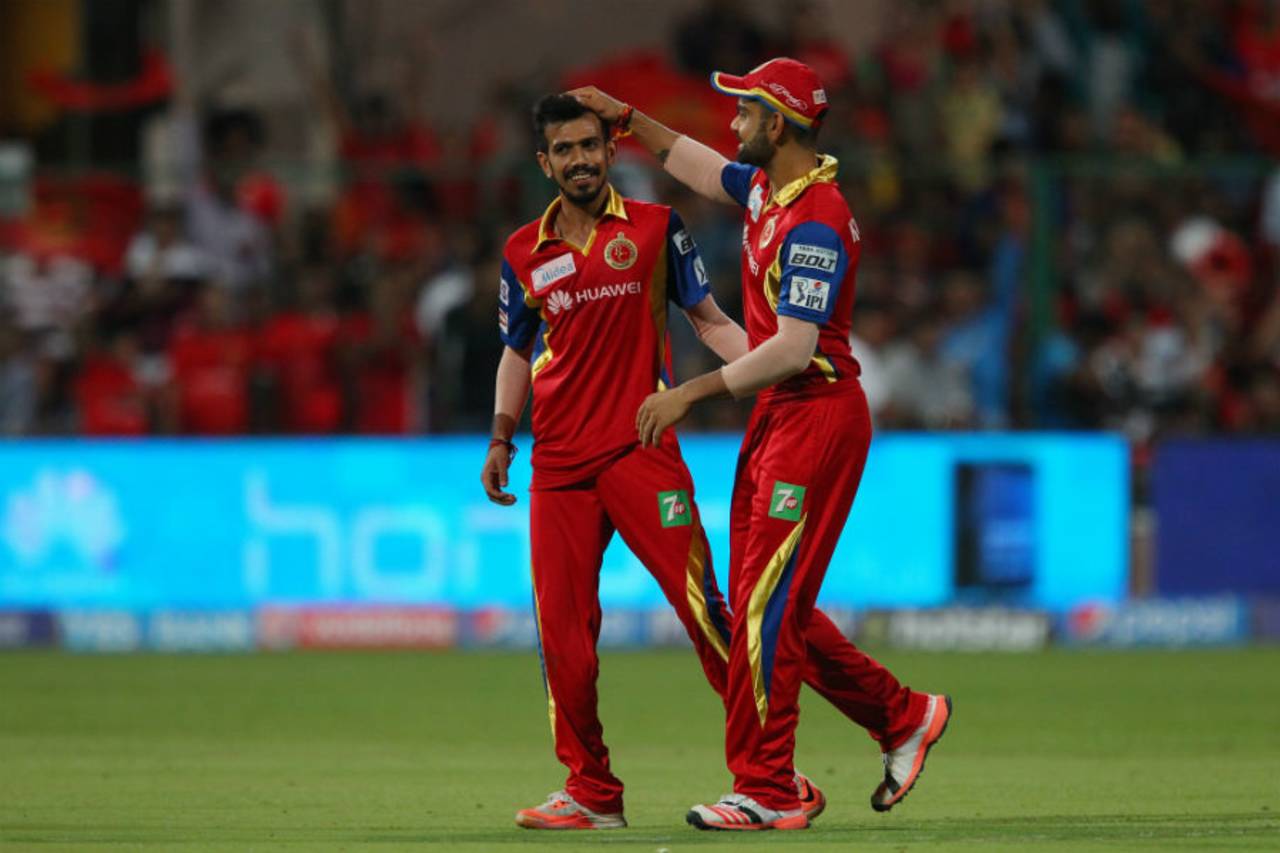Chahal thrives with new-age tactics
Yuzvendra Chahal hasn't been a one-season wonder in the IPL. He has done better this year, both in terms of striking when required as well as preventing a scoring spree in the middle stages
Arun Venugopal
21-May-2015

"Virat always tells me not to worry about being hit for sixes. He backs me to bowl whatever I want to bowl and keep a big heart" • BCCI
Yuzvendra Chahal's simple approach to bowling is perhaps best conveyed through his glitch-free action: a brisk, short run that culminates in a rapid rotation of the arms - fluid from start to finish. Chahal is by no means endowed with an overflowing bag of tricks. But he is good at what he does. Good enough to earn 21 wickets and stand on top of Royal Challengers Bangalore's wicket-takers' list, ahead of spearhead Mitchell Starc.
His economy rate of 9.03 runs per over doesn't entirely reflect the suffocating effect he has on batsmen at times. In pursuit of a release, they try to go boom against him, but end up going bust. Ashwini Kumar, coach of Haryana, the team for which Chahal plays in the domestic circuit, said his "lower trajectory" bowling makes him very hard to hit.
"If you look minutely at his bowling action, Chahal never gets the ball to bounce over knee height," Ashwini told ESPNcricinfo. "For the batsman to be in his comfort zone while hitting a long ball he needs good bounce. For a tall batsman, Chahal's ball reaches the toe end of the bat. You can hit him only when he bowls short, otherwise it's difficult. That is a very important reason for his success in T20s."
It's difficult to approximate how much Chahal's background as a chess player - he has represented the country at the age-group level in the sport before giving it up for cricket in his teens - influences his thinking. However, his ability to roll with the punches and swiftly stand up to strike back is right out of blitz chess.
During the rained-out Delhi Daredevils game at the Chinnaswamy Stadium last Sunday, Chahal was hit for three sixes in an over, by JP Duminy and Yuvraj Singh. His first delivery to Duminy was liberally tossed up. He followed that up with a flatter one.
Yuvraj, for his part, jumped out of the crease and hit him with the spin over deep midwicket. Chris Gayle, from short third man, gestured to Chahal that he kept the next ball outside off. Chahal appeared to be thinking on similar lines. He slowed the pace, flighted it well and Yuvraj's punt wasn't good enough to clear long-off.
Chahal acknowledged the support he received from his team whenever he went for runs. "Virat [Kohli] and [Daniel] Vettori sir have given me a lot of confidence in that regards," Chahal said.
"Vettori sir tells us not to think about the ball you've been hit for. Forget about it and concentrate on the next ball. That really helps in a T20 game. Virat always tells me not to worry about being hit for sixes. He backs me to bowl whatever I want to bowl and keep a big heart."

Haryana coach Ashwini Kumar: "You can hit him only when he bowls short, otherwise it's difficult. That is a very important reason for his success in T20s"•BCCI
Chahal hasn't been a one-season wonder in the IPL. After moving from Mumbai Indians to Royal Challengers in 2014, he did well to claim 12 wickets at a creditable economy rate of 7.01. He has done better this year, both in terms of striking when required as well as preventing a scoring spree in the middle stages. Along with Starc and Harshal Patel, he has considerably strengthened what was once a not-so-robust bowling line-up.
But, for all his success in the IPL, his returns in Ranji Trophy have been meagre. Chahal, 24, has played only 17 first-class matches for 32 wickets, since his debut in 2009. In the 2014-15 Ranji season, he played only two matches and picked up as many wickets. He turned out in two games only in the previous season as well, for three wickets.
In the Syed Mushtaq Ali Trophy, the domestic T20 tournament, too, he didn't do a great deal this season, claiming two wickets from four games. Ashwini believed his underwhelming showing was a combination of factors.
"You know that Amit Mishra is also part of the Haryana team, and from a team-composition point of view, there can't be two legspinners unless one of them is an allrounder.
"Amit has done well with the bat in the Ranji Trophy. Yuzvendra doesn't bat that well. Also, Yuzvendra needs to mature further in the longer format."
Ashwini said Chahal's strengths in T20 cricket went against him in the four-day format. "He doesn't flight the ball much, which is why he is successful in T20s and not so much in four-day cricket. When you play T20, you have to bowl dot balls. This is the most-discussed thing. In four-day games, you need to play on the batsmen's patience, lalchaana padta hai (you need to tempt them). You can't attempt the dot-ball formula in four-day cricket."
Ashwin also felt Chahal didn't appear very interested in the longer format, but said the fact that he received fewer opportunities might have been a factor. "He could probably be thinking about establishing his place in the side in the shorter formats, as he doesn't get a regular run in the Ranji matches. Also the Lahli wicket [Haryana's home ground] is pacer-friendly. So there are lots of factors."
He said Chahal's success in the IPL, however, will rub on to other formats he plays. "He is a keen learner and picks up things quickly. He will mature with time and we want to make good use of him."
Arun Venugopal is a senior sub-editor at ESPNcricinfo